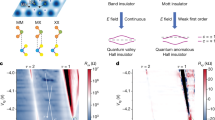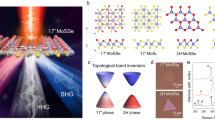Abstract
The realization of all-optical switching, modulating and computing devices is an important goal in modern optical technology. Nonlinear optical materials with large third-order nonlinear susceptibilities (χ(3)) are indispensable for such devices, because the magnitude of this quantity dominates the device performance. A key strategy in the development of new materials with large nonlinear susceptibilities is the exploration of quasi-one-dimensional systems1,2, or ‘quantum wires’—the quantum confinement of electron–hole motion in one-dimensional space can enhance χ(3). Two types of chemically synthesized quantum wires have been extensively studied: the band insulators of silicon polymers, and Peierls insulators of π-conjugated polymers and platinum halides. In these systems, χ(3) values of 10-12 to 10-7 e.s.u. (electrostatic system of units) have been reported3,4,5,6,7. Here we demonstrate an anomalous enhancement of the third-order nonlinear susceptibility in a different category of quantum wires: one-dimensional Mott insulators of 3 d transition-metal oxides and halides. By analysing the electroreflectance spectra of these compounds, we measure χ(3) values in the range 10-8 to 10-5 e.s.u. The anomalous enhancement results from a large dipole moment between the lowest two excited states of these systems.
This is a preview of subscription content, access via your institution
Access options
Subscribe to this journal
Receive 51 print issues and online access
$199.00 per year
only $3.90 per issue
Buy this article
- Purchase on Springer Link
- Instant access to full article PDF
Prices may be subject to local taxes which are calculated during checkout




Similar content being viewed by others
References
Auston, D. H. et al. Research on nonlinear optical materials: an assessment. Appl. Opt. 26, 211–234 ( 1987).
Sauteret, C. et al. Optical nonlinearities in one-dimensional-conjugated polymer crystals. Phys. Rev. Lett. 36, 956– 959 (1976).
Hasegawa, T. et al. Nonlinear optical spectroscopy on one-dimensional excitons in silicon polymer, polysilane. Phys. Rev. Lett. 69 , 668–671 (1992).
Fann, W.-S. et al. Spectrum of χ(3)(-3ω;ω,ω,ω) in polyacetylene: an application of the free-electron laser in nonlinear optical spectroscopy. Phys. Rev. Lett. 62, 1492– 1495 (1989).
Iwasa, Y. et al. Nonlinear optical study of quasi-one-dimensional platinum complexes: Two-photon excitonic resonance effect. Appl. Phys. Lett. 59, 2219–2221 (1991).
Bubeck, C. et al. Resonant degenerate four wave mixing and scaling laws for saturable absorption in thin films of conjugated polymers and Rhodamine 6G. Chem. Phys. 154, 343–348 (1991).
Halvorson, C. et al. Conjugated polymers with degenerate ground state. The route to high performance third-order nonlinear optical response. Chem. Phys. Lett. 200, 364–368 (1992).
Imada, M., Fujimori, A. & Tokura, Y. Metal-insulator transitions. Rev. Mod. Phys. 70, 1039–1263 ( 1998).
Motoyama, N., Eisaki, H. & Uchida, S. Magnetic susceptibility of ideal spin 1/2 Heisenberg antiferromagnetic chain systems, Sr2CuO3 and SrCuO 2. Phys. Rev. Lett. 76, 3212– 3215 (1996).
Toriumi, K. et al. Synthesis and crystal structure of a novel one-dimensional halogen-bridged NiIII-X-NiIII compounds, {[Ni(R,R-chxn)2Br]Br2}∞. J. Am. Chem. Soc. 111, 2341– 2342 (1989).
Okamoto, H., Toriumi, K., Mitani, T. & Yamashita, M. Optical and magnetic properties of the halogen-bridged metal complexes modified by hydrogen bondings: {M(1R,2R-cyclohexanediamine)2Br}Br 2 (M = Pt, Pd, and Ni). Phys. Rev. B 42 , 10381–10387 (1990).
Okamoto, H. et al. Electronic structure of the quasi-one-dimensional halogen-bridged Ni complexes [Ni(chxn)2X]X2 (X = Cl, Br) and related Ni compounds. Phys. Rev. B 54 , 8438–8445 (1996).
Seraphin, B. O. Optical field effect in silicon. Phys. Rev. 140, A1716–A1725 (1965).
Cardona, M. Modulation Spectroscopy (Academic, New York, 1969).
Tokura, Y. et al. Optical spectra in polydiacetylene crystals substituted with fluorobenzenes. J. Chem. Phys. 85, 99– 104 (1986).
Butcher, P. N. & Cotter, D. The Elements of Nonlinear Optics (Cambridge University Press, 1990).
Aspnes, D. E. & Rowe, J. E. Resonant nonlinear optical susceptibility: electroreflectance in the low-field limit. Phys. Rev. B 5, 4022–4030 (1972).
Stegeman, G. I. & Wright, E. M. All-optical waveguide switching. Opt. Quantum Electron. 22, 95–122 (1990).
Stegeman, G. I. & Torruellas, W. E. Nonlinear materials for information processing and communications. Phil. Trans. R. Soc. Lond. A 354, 745–756 (1996).
Suzuura, H. et al. Singularities in optical spectra of quantum spin chains. Phys. Rev. Lett. 76, 2579–2582 (1996).
Roessler, D. M. Kramers-Kronig analysis of reflection data. Br. J. Appl. Phys. 16, 1119–1123 ( 1965).
Wada, Y. & Yamashita, M. Electric-field effects on the charge-transfer excitation in quasi-one-dimensional halogen-bridged mixed-valence Pt complexes: [Pt(ethylenediamine)2] [Pt(ethylenediamine) 2X2](ClO4)4 (X = Cl, Br, I). Phys. Rev. B 42, 7398– 7404 (1990).
Phillips, S. D. et al. Electroabsorption of polyacetylene. Phys. Rev. B 40, 9751–9759 ( 1989).
Hasegawa, T. et al. Analysis of excitonic resonant effect in the third-order nonlinear optical susceptibility of polydiacetylene films. Synth. Met. 43, 3151–3156 (1991).
Gelsen, O. M. et al. Spectroscopic investigation of the electro-optic nonlinearity in poly(2,5-thienylene vinylene). J. Appl. Phys. 71 , 1064–1066 (1992).
Acknowledgements
This work was supported by a grant-in-aid from the Ministry of Education, Science, Sports, and Culture of Japan.
Author information
Authors and Affiliations
Corresponding author
Rights and permissions
About this article
Cite this article
Kishida, H., Matsuzaki, H., Okamoto, H. et al. Gigantic optical nonlinearity in one-dimensional Mott–Hubbard insulators . Nature 405, 929–932 (2000). https://doi.org/10.1038/35016036
Received:
Accepted:
Issue Date:
DOI: https://doi.org/10.1038/35016036
This article is cited by
-
Terahertz radiation by quantum interference of excitons in a one-dimensional Mott insulator
Nature Communications (2023)
-
Macro- and atomic-scale observations of a one-dimensional heterojunction in a nickel and palladium nanowire complex
Nature Communications (2022)
-
Topology and geometry under the nonlinear electromagnetic spotlight
Nature Materials (2021)
-
Generalized Kramers–Kronig relations and sum rules for moments and powers of degenerate four wave mixing susceptibility
Optical Review (2021)
-
Biexciton in one-dimensional Mott insulators
Communications Physics (2019)
Comments
By submitting a comment you agree to abide by our Terms and Community Guidelines. If you find something abusive or that does not comply with our terms or guidelines please flag it as inappropriate.



